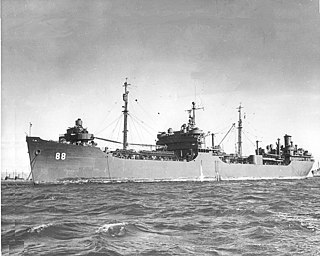USS Merrimack, or variant spelling USS Merrimac, may be any one of several ships commissioned in the United States Navy and named after the Merrimack River.

Ulithi is an atoll in the Caroline Islands of the western Pacific Ocean, about 191 km (103 nmi) east of Yap. It consists of 40 islets totalling 4.5 km2, surrounding a lagoon about 36 km (22 mi) long and up to 24 km (15 mi) wide—at 548 km2 (212 sq mi) one of the largest in the world. It is administered by the state of Yap in the Federated States of Micronesia. Ulithi's population was 773 in 2000. There are four inhabited islands on Ulithi Atoll. They are Falalop, Asor (Yasor), Mogmog (Mwagmwog), and Fedarai (Fedraey). Falalop is the most accessible with Ulithi Airport, a small resort hotel, store and one of three public high schools in Yap state. Mogmog is the seat of the high chief of Ulithi Atoll though each island has its own chief. Other important islands are Losiap, Sorlen (Sohl'oay), and Potangeras (Potoangroas).
Three ships of the United States Navy have been named Cumberland, after the Cumberland River.

USS Mississinewa (AO-59) was the first of two United States Navy ships of the name. She was a T3-S2-A1 oiler of the US Navy, laid down on 5 October 1943 by the Bethlehem Sparrows Point Shipyard, Inc., Sparrows Point, Maryland; launched on 28 March 1944; sponsored by Miss Margaret Pence; and commissioned on 18 May 1944. Mississinewa was commanded by Captain Philip G. Beck.
USS Pecos may refer to the following ships of the United States Navy:

The Cimarron-class oilers were an underway replenishment class of oil tankers which were first built in 1939 as "National Defense Tankers," United States Maritime Commission Type T3-S2-A1, designed "to conform to the approved characteristics for naval auxiliaries in speed, radius and structural strength", anticipating their militarization in the event of war. "Tentative plans had been reached with the Standard Oil Company of New Jersey to build ten high-speed tankers with the government paying the cost of the larger engines needed for increased speed. By the first week in December [1937], Standard Oil had solicited and received bids from a number of yards providing for the construction of a number of 16,300-ton (deadweight) capacity tankers. Bids were requested for two versions: a single-screw design of 13 knots and a twin-screw design of 18 knots. The price difference between the two would be used to establish the government's cost subsidy for greater speed. Plans and specifications for both designs were prepared for Standard Oil by naval architect E. L. Stewart. It seems certain that the design for the 18-knot tanker evolved out of the bureau's (C&R) design for a fleet oiler."

SS Mission Dolores was a Mission Buenaventura-class oiler built for the United States Maritime Commission during World War II, named for Mission San Francisco de Asís in San Juan Capistrano, California, one of two named for the Franciscan mission located in San Francisco, California.
USS Platte may refer to the following ships of the United States Navy:

USS Lyman (DE-302) was an Evarts-class destroyer escort of the United States Navy during World War II. She served in the Pacific Theatre, escorting convoys and other ships. She received a total of five battle stars for her service during the war, but was decommissioned and sold for scrap within 18 months of the war's end.

USS Tomahawk (AO-88) was an Escambia-class fleet oiler acquired by the United States Navy for use during World War II. She had the dangerous but necessary task of providing fuel to vessels in combat and non-combat areas primarily in the Pacific Ocean. For her valiant efforts, she received six battle stars during the war.
Six ships of the United States Navy have been named USS Kanawha and one has been named USS Kanawha II:
Two ships of the United States Navy have been named Conecuh, after the Conecuh River in Alabama:

USS Mississinewa (AO-144) was a Neosho-class fleet oiler of the United States Navy in service from 1955 to the early 1990s.
USS Tippecanoe may refer to:
SS Mission Los Angeles may refer to one of two Type T2 tankers built for the United States Maritime Commission by Marinship Corporation:
SS Mission San Francisco may refer to one of two Type T2 tankers built for the United States Maritime Commission by Marinship Corporation:
SS Mission Santa Ana may refer to one of two Type T2 tankers built for the United States Maritime Commission by Marinship Corporation:
Mississinewa may refer to:

The T3 tanker, or T3, are a class of seaworthy large tanker ships produced in the United States and used to transport fuel oil, gasoline or diesel before and during World War II, the Korean War and the Vietnam War. The T3 tanker classification is still used today. The T3 tanker has a full load displacement of about 24,830 tons.
This page is based on this
Wikipedia article Text is available under the
CC BY-SA 4.0 license; additional terms may apply.
Images, videos and audio are available under their respective licenses.







